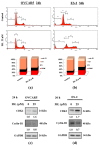Isoliquiritigenin Induces Autophagy and Inhibits Ovarian Cancer Cell Growth
- PMID: 28934130
- PMCID: PMC5666707
- DOI: 10.3390/ijms18102025
Isoliquiritigenin Induces Autophagy and Inhibits Ovarian Cancer Cell Growth
Abstract
Ovarian cancer is one of the commonest gynecologic malignancies, which has a poor prognosis for patients at the advanced stage. Isoliquiritigenin (ISL), an active flavonoid component of the licorice plant, previously demonstrated antioxidant, anti-inflammatory, and tumor suppressive effects. In this study, we investigated the antitumor effect of ISL on human ovarian cancer in vitro using the human ovarian cancer cell lines, OVCAR5 and ES-2, as model systems. Our results show that ISL significantly inhibited the viability of cancer cells in a concentration- and time-dependent manner. Flow cytometry analysis indicated that ISL induced G2/M phase arrest. Furthermore, the expression of cleaved PARP, cleaved caspase-3, Bax/Bcl-2 ratio, LC3B-II, and Beclin-1 levels were increased in western blot analysis. To clarify the role of autophagy and apoptosis in the effect of ISL, we used the autophagy inhibitor-3-methyladenine (3-MA) to attenuate the punctate fluorescence staining pattern of the p62/sequestosome 1 (SQSTM1, red fluorescence) and LC3 (green fluorescence) proteins after ISL treatment, and 3-MA inhibited the cytotoxicity of ISL. These findings provide new information about the link between ISL-induced autophagy and apoptosis and suggest that ISL is a candidate agent for the treatment of human ovarian cancer.
Keywords: apoptosis; autophagy; isoliquiritigenin; ovarian cancer.
Conflict of interest statement
The authors declare no conflict of interest.
Figures






References
-
- Health Grove, 2017. [(accessed on 4 February 2016)]; Available online: http://conditions.healthgrove.com/l/754/Ovarian-Cancer#Global%20Statisti....
-
- American Cancer Society, 2017. [(accessed on 1 July 2016)]; Available online: https://www.cancer.org/cancer/ovarian-cancer/detection-diagnosis-staging....
MeSH terms
Substances
LinkOut - more resources
Full Text Sources
Other Literature Sources
Research Materials

